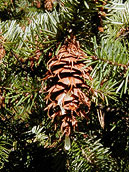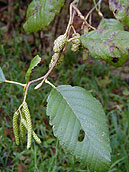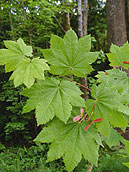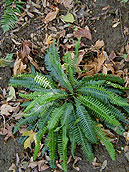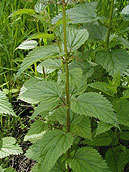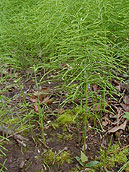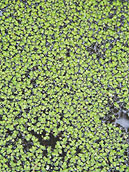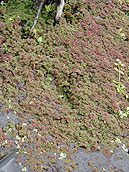Natural History of the Canyon
Canyon Plants
Trees | Shrubs | Ferns | Herbs | Wetland Plants
 To give you an introduction to the botany of the Reed Canyon, we've put together a guide to some of the most common plants. The photos and descriptions on this page should help you recognize the predominant native plants, as well as a few naturalized non-natives. These are the plants that we expect to see in the canyon for years to come. (To see the plants that we are trying to remove, visit the Invasive Weeds page.)
To give you an introduction to the botany of the Reed Canyon, we've put together a guide to some of the most common plants. The photos and descriptions on this page should help you recognize the predominant native plants, as well as a few naturalized non-natives. These are the plants that we expect to see in the canyon for years to come. (To see the plants that we are trying to remove, visit the Invasive Weeds page.)
We've deliberately kept this list short, but you can get more detailed information about what grows in the canyon by checking the Canyon Plants list written by Bruce Moreira and Helen Stafford. You can also see the on-line enhancement plan to get information about what's currently being planted in the canyon as part of the ongoing restoration project.
For more photographs and detailed information on the species listed below, check out our resource page where you'll find links to some of the great databases on the web.
Trees
(click on any photo for a close-up)
Douglas-fir
Pseudotsuga menziesii
Douglas-fir is the state tree of Oregon and the most common tree on the west side of the Cascades. It's easy to recognize by the three-pointed bracts sticking out of the cones.
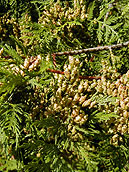 Western redcedar
Western redcedar
Thuja plicata
Redcedar was the most important wood for the native Americans in the Pacific Northwest, who used it to make canoes, lodges, totem poles, and more. You can recognize it by the scale-like needles and the small, upright cones.
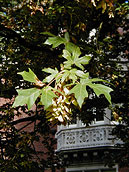 Bigleaf maple
Bigleaf maple
Acer macrophyllum
These are the large maples that grow by the cross-canyon bridge. You can recognize them by the size of the leaves (up to 15 in. across) and by the fuzzy, winged seeds called "samaras."
Alders like the cool, moist environment near the water in the canyon. They're an important part of the ecosystem because they "fix" nitrogen from the air and make it available to other plants.
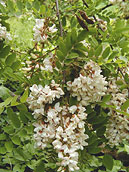 Black Locust
Black Locust
Robinia pseudoacacia
This is another tree that can "fix" atmospheric nitrogen and add it to the soil. Black locusts aren't native to this region but a row of them were planted many years ago on the north side of the canyon between the footbridge and the springs. They produce masses of fragrant flowers, but the branches have sharp thorns.
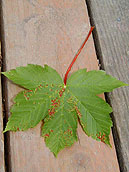 Sycamore Maple
Sycamore Maple
Acer pseudoplatanus
Sycamore maples are often planted as ornamentals but they can be very invasive in wetland areas. The oldest ones on the Reed campus were planted in a former tree nursury beside what is now the ETC. From there they have spread widely into the canyon below the Chemistry building.
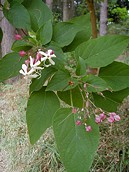 Glorybower
Glorybower
Clerodendrum trichotomum
This tree is native to Japan but it's widely planted in Portland as an ornamental and there's one in the canyon near the pipe. It has fragrant flowers that bloom in late summer.
Shrubs
(click on any photo for a close-up)
Vine maple is a very common native shrub on the west side of the Cascades in Oregon. In the perfect conditions it can grow as a tree up to 30 feet high, but it usually just spreads horizontally to form a wide bush. Vine maple leaves generally have 9 lobes in a circular shape like a pinwheel. The young samaras are red and their wings are spread much wider than in other maples.
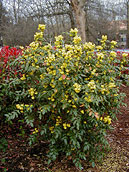 Tall Oregon-grape
Tall Oregon-grape
Mahonia aquifolium
Some people mistake this plant for the invasive English holly, but it's actually a native. The leaves are shiny green and have small thorns. The small purple berries that appear in late fall resemble grapes and are used for making jam. This has been the state flower of Oregon since 1899 and, in fact, the governor's mansion in Salem is named "Mahonia Hall."
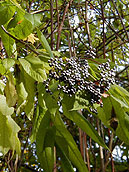 Blue Elderberry
Blue Elderberry
Sambucus nigra ssp. cerulea
Blue elderberry is found in the east end of the canyon and in other moist, open areas in western Oregon. It is an important food source for wildlife. Deer and elk eat the leaves, many species of birds eat the berries, and hummingbirds drink nectar from the flowers. Humans use the berries in jams, jellies, pies, and wine. (Many guidebooks still identify blue elderberry by the older names of S. cerulea and S. mexicana.)
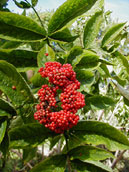 Red Elderberry
Red Elderberry
Sambucus racemosa
The color of these berries should be a warning to potential pickers. Although they provide food for many birds and other wildlife, red elderberries are toxic to humans (at least when eaten raw). The bushes tend to be found in moist, disturbed areas.
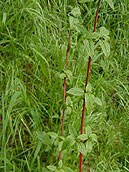 |
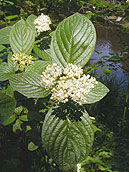 |
Red-Osier Dogwood
Cornus sericea
This is a deciduous shrub that has bright red stems on the new growth in the spring. It has small white flowers that grow in flat-topped clusters. It grows in nitrogen-rich, saturated areas and is common around the edges of the water in the canyon.
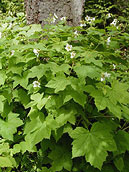 Thimbleberry
Thimbleberry
Rubus parviflorus
Thimbleberry is the nice, native cousin of Himalayan blackberry. Both plants are in the genus Rubus but, unlike its invasive relative, thimbleberry has soft, fuzzy leaves, attractive flowers, and no thorns. The fruits are full of seeds and not particularly tasty, but they provide food for bears, squirrels, skunks, and other mammals, as well as many types of birds. Thimbleberries are some of the first plants to revegetate clearcuts.
- back to top -
Ferns
(click on any photo for a close-up)
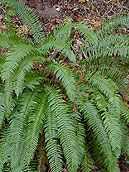 Sword Fern
Sword Fern
Polystichum munitum
This is one of the most common (and rugged) ferns of the Pacific northwest. It's one of the last ferns to succumb to ivy and other invasive species. The blades resemble little swords.
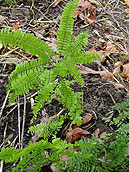 Maidenhair Fern
Maidenhair Fern
Adiantum aleuticum
This fern gets its name from its wiry, dark, shiny stalk that looks like hair. It grows almost exclusively on vertical or near-vertical rock faces where there's plenty of moisture and protection from direct sunlight. You can find it around waterfalls and in old wells dug by pioneers.
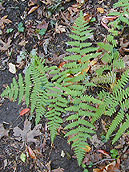 Bracken Fern
Bracken Fern
Pteridium aquilinum
Bracken fern spreads by underground rhizomes and produces fronds that grow several feet high and then die and turn brown in winter. The dead fronds are highly flammable and encourage the wildfires that help the plant reproduce. Bracken fern produces little or no food for wildlife and all parts of the plant, including the spores, are carcinogenic.
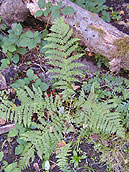 Lady Fern
Lady Fern
Athyrium filix-femina
Lady fern is most easily recognized by the diamond or oval shape of the fronds.
Not a common fern on the Reed Campus, but it is being planted as part of the ongoing restoration.
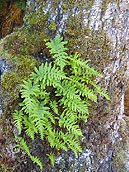 Licorice Fern
Licorice Fern
Polypodium glycyrrhiza
Licorice fern gets its name from the taste of its rhizomes. You can find it growing as an epiphyte on many bigleaf maples around campus.
click on any photo for a close-up
Herbs
(click on any photo for a close-up)
This is one canyon plant that most of us learn very quickly. It has square stems with opposite, lance-shaped leaves and it's covered with tiny hairs that inject formic acid into the skin. The stinging sensation can last for several days.
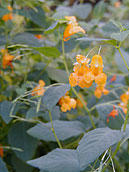 Yellow Touch-Me-Not
Yellow Touch-Me-Not
Impatiens noli-tangere
Touch-me-not is a tall herb that grows on the mud flats in the upper end of the canyon. It blooms in late summer and then quickly withers away. The plant gets its name from the seed capsules that burst open to eject the seeds when you touch them.
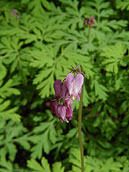 Pacific Bleeding Heart
Pacific Bleeding Heart
Dicentra formosa
A close look at the flowers of this plant will quickly suggest how it got its common name. Bleeding heart is too fragile for the more heavily visited parts of the canyon, but it does well in the area below the Art Building.
Wetland Plants
(click on any photo for a close-up)
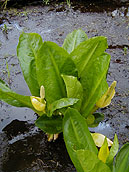 Skunk Cabbage
Skunk Cabbage
Lysichiton americanus
Skunk cabbage is easy to recognize by the broad green leaves, the spike of bright yellow flowers, and (of course) the smell. These perennials can be seen throughout the canyon from March through October, but only the underground stems persist through the winter. (Many books list this plant as "Lysichitum americanum.")
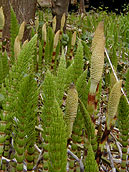 Giant Horsetail Equisetum telmateia |
Reed has two species of horsetails that grow in thick clumps in the canyon. Each species spreads through underground rhizomes, and each pushes up two distinct types of aerial stems in the spring. The fertile stems, which are unbranched, produce large cones full of spores and then wither away. The sterile stems produce whorls of green branches and persist through the summer.
Distinguishing between the two species is mostly a matter of size. The stalks of common horsetail have diameters of 1.5-5mm, while the stalks of giant horsetail have diameters of 0.5-2 cm. Common horsetail is generally found in the upper end of the canyon near the Chemistry building, while giant horsetail is commonly found in the lower canyon near the Theatre building.
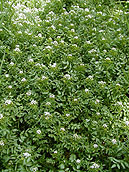 Water-Cress
Water-Cress
Rorippa nasturtium-aquaticum
A very common bushy, aquatic plant that fills the wet, shallow areas of the canyon. It blooms in the springtime with small white blossoms. Some people eat it in salads (but we ask them not to pick it here in the canyon).
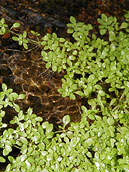 Water-Starwort
Water-Starwort
Callitriche heterophylla
Water-starwort grows up to 40 cm long and forms thick green mats in the shallow, flowing water at the east and west ends of the canyon. One end of the stem is rooted in the mud and the other end has green, oval leaves floating on the surface.
Duckweed is a small, free-floating plant that spreads rapidly by budding and sometimes covers the surface of the lake. Each plant consists of a single leaf (2-5 mm wide) and a single root (1-12 cm long). Duckweed rarely goes into flower and the flowers it produces are almost microscopic.
"Water-moss" might be a better name for this plant. It looks like a tiny moss growing on the surface of the water. The plants are generally less than 2 cm wide and are often mixed in with duckweed. (You can see bits of duckweed and water-starwort in the photo above.)
"What's that green glob on top of the water?"
Even if you don't want to go sloshing around in the canyon, you can make a good guess about which plant you're seeing just by the speed and depth of the water.
Water-starwort is rooted in the mud and does well in the flowing waters of the creek where duckweed would be washed away.
Duckweed and water-fern, on the other hand, are free-floating and can thrive in parts of the lake that are too deep for rooted plants like water-starwort.
All three plants tend to mix together in still, shallow areas around the lake.
